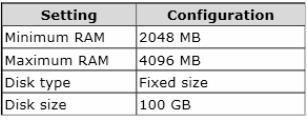File Info
| Exam | Installing and Configuring Windows Server 2012 |
| Number | 70-410 |
| File Name | Microsoft.70-410.CertKiller.2019-02-28.315q.tqb |
| Size | 12 MB |
| Posted | Feb 28, 2019 |
| Download | Microsoft.70-410.CertKiller.2019-02-28.315q.tqb |
How to open VCEX & EXAM Files?
Files with VCEX & EXAM extensions can be opened by ProfExam Simulator.
Coupon: MASTEREXAM
With discount: 20%





Demo Questions
Question 1
You have a server named Server1 that runs Windows Server 2012 R2. Server1 has the Hyper-V server role installed.
An iSCSI SAN is available on the network.
Server1 hosts four virtual machines named VM1, VM2, VM3, and VM4.
You create a LUN on the SAN to host the virtual hard drive files for the virtual machines.
You need to create a 3-TB virtual hard disk for VM1 on the LUN. The solution must prevent VM1 from being paused if the LUN runs out of disk space.
Which type of virtual hard disk should you create on the LUN?
- Dynamically expanding VHDX
- Fixed-size VHDX
- Fixed-size VHD
- Dynamically expanding VHD
Correct answer: B
Explanation:
The virtual disk needs to be a VHDX file since it is going to be over 2TB in size and it must be fixed-size so that the space is already taken on the server (that way the server does not run out of space as the volume grows) even if the actual virtual disk does not yet hold that amount of data. The virtual disk needs to be a VHDX file since it is going to be over 2TB in size and it must be fixed-size so that the space is already taken on the server (that way the server does not run out of space as the volume grows) even if the actual virtual disk does not yet hold that amount of data.
Question 2

Your network contains an Active Directory domain named contoso.com. The domain contains a server named Server1. Server1 runs Windows Server 2012 R2 and has the Hyper-V server role installed.
On Server1, you create and start a virtual machine named VM1. VM1 is configured as shown in the following table.

You need to recommend a solution to minimize the amount of disk space used for the checkpoint of VM1.
What should you do before you create the checkpoint?
- Run the Resize-VHD cmdlet.
- Convert Disk1.vhd to a dynamically expanding disk.
- Shut down VM1.
- Run the Convert-VHD cmdlet.
Correct answer: C
Explanation:
Changing between a fixed and dynamic disk type does not alter the size of a SNAPSHOT much at all. However, since a snapshot is a record of a VMs state at the exact time that the snapshot was taken, shutting down the VM before taking the snapshot prevents the snapshot from having to contain all of the data in RAM (as there is no data in memory when a machine is powered down). The question states that the solution should minimize the amount of disk space used for the checkpoint of VM1. If the checkpoint is taken while VM1 is running, there will be two attritional files present at the checkpoint location; a .VSV with VM1 saved state files and a .BIN file which contains VM1’s memory contents. If, however, VM1 is shut down first, these files will not be created, thus saving disk space. In order to convert Disk1.vhd to a dynamically expanding disk, VM1 still have to be shut down. Changing between a fixed and dynamic disk type does not alter the size of a SNAPSHOT much at all.
However, since a snapshot is a record of a VMs state at the exact time that the snapshot was taken, shutting down the VM before taking the snapshot prevents the snapshot from having to contain all of the data in RAM (as there is no data in memory when a machine is powered down).
The question states that the solution should minimize the amount of disk space used for the checkpoint of VM1. If the checkpoint is taken while VM1 is running, there will be two attritional files present at the checkpoint location; a .VSV with VM1 saved state files and a .BIN file which contains VM1’s memory contents. If, however, VM1 is shut down first, these files will not be created, thus saving disk space.
In order to convert Disk1.vhd to a dynamically expanding disk, VM1 still have to be shut down.
Question 3
You have a print server named Server1 that runs Windows Server 2012 R2.
You discover that when there are many pending print jobs, the system drive occasionally runs out of free space.
You add a new hard disk to Server1.You create a new NTFS volume.
You need to prevent the print jobs from consuming disk space on the system volume.
What should you modify?
- The properties on the new volume
- The properties of the Print Spooler service
- The Print Server Properties
- The properties of each shared printer
Correct answer: C
Explanation:
Windows spools print jobs by default to the following directory as they are processed:%SystemRoot%\SYSTEM32\SPOOL\PRINTERS. It is possible for the administrator of a Windows print server to manually instruct Windows the location for placing the spool files, if for example there is a concern for disk space. Windows spools print jobs by default to the following directory as they are processed:
%SystemRoot%\SYSTEM32\SPOOL\PRINTERS.
It is possible for the administrator of a Windows print server to manually instruct Windows the location for placing the spool files, if for example there is a concern for disk space.

